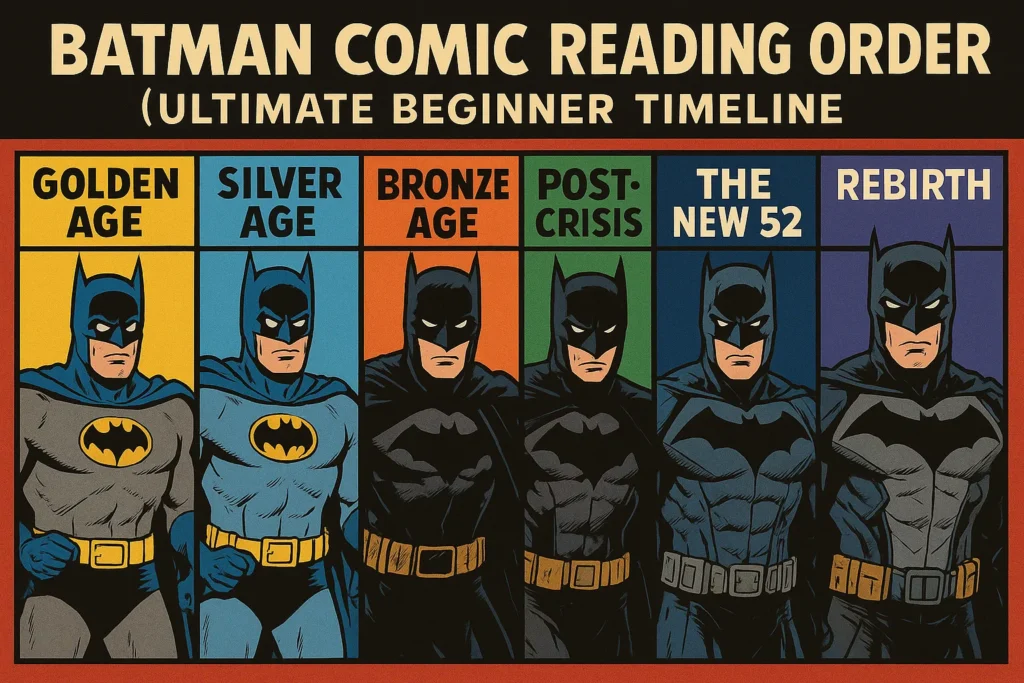
Batman Comic Reading Order (Ultimate Beginner Timeline)
Table of content
Table of Contents
Since his debut in Detective Comics #27 in 1939, Batman has become one of the most enduring and complex figures in pop culture. Over the past 85+ years, the Dark Knight has starred in thousands of issues, across dozens of titles, reboots, alternate universes, and groundbreaking story arcs.
But with that legacy comes a problem:
Where do you even begin?
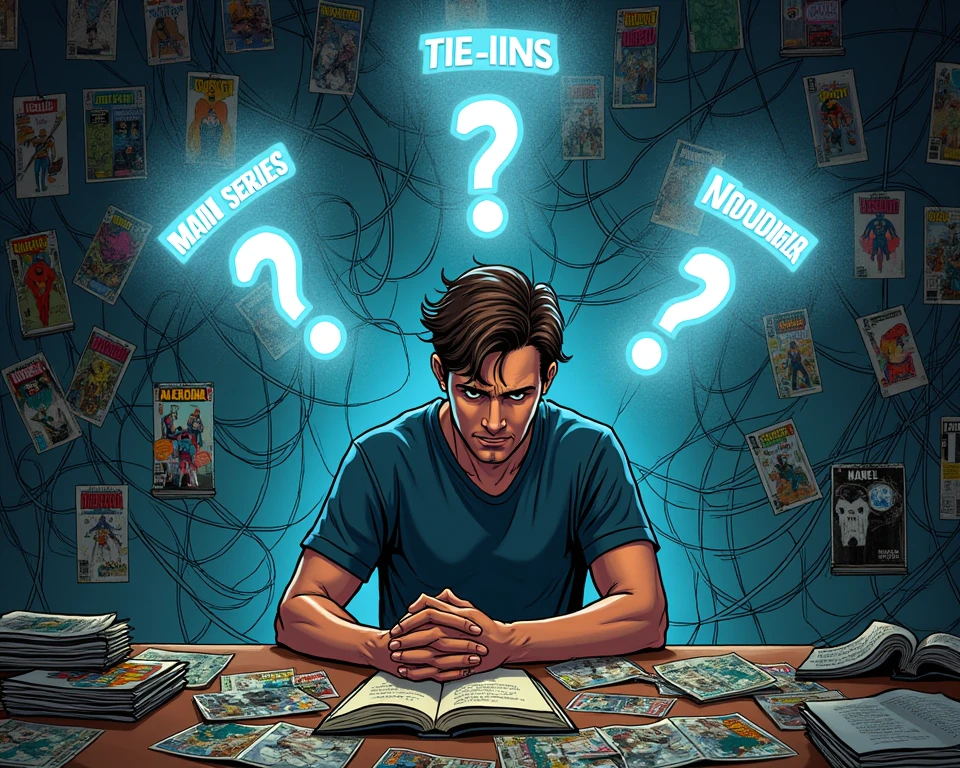
From the noir-inspired tales of the Golden Age to the psychologically rich sagas of the Modern Era, Batman’s publishing history can feel intimidating—especially for new readers or casual fans wanting to dive deeper into his world.
That’s why this guide exists.
This isn’t just a random list of comics. It’s a structured, era-by-era roadmap designed to walk you through Batman’s evolution in a way that makes sense. Whether you’re a newcomer curious about his origin stories, a returning fan looking to catch up, or a collector organizing your shelves, this guide gives you:
- A chronological overview of major Batman eras (Golden Age to Rebirth and beyond)
- Essential story arcs and graphic novels you shouldn’t miss
- Recommended starting points for different types of readers
- External resources for even deeper exploration
Batman isn’t just one story. He’s a mythology, shaped by the times and the creators behind the cowl. This Batman Comic Reading Order guide will help you read him right—from Gotham’s darkest alleys to its most explosive events.
1. Golden Age & Silver Age: The Origins (1939–1970s)
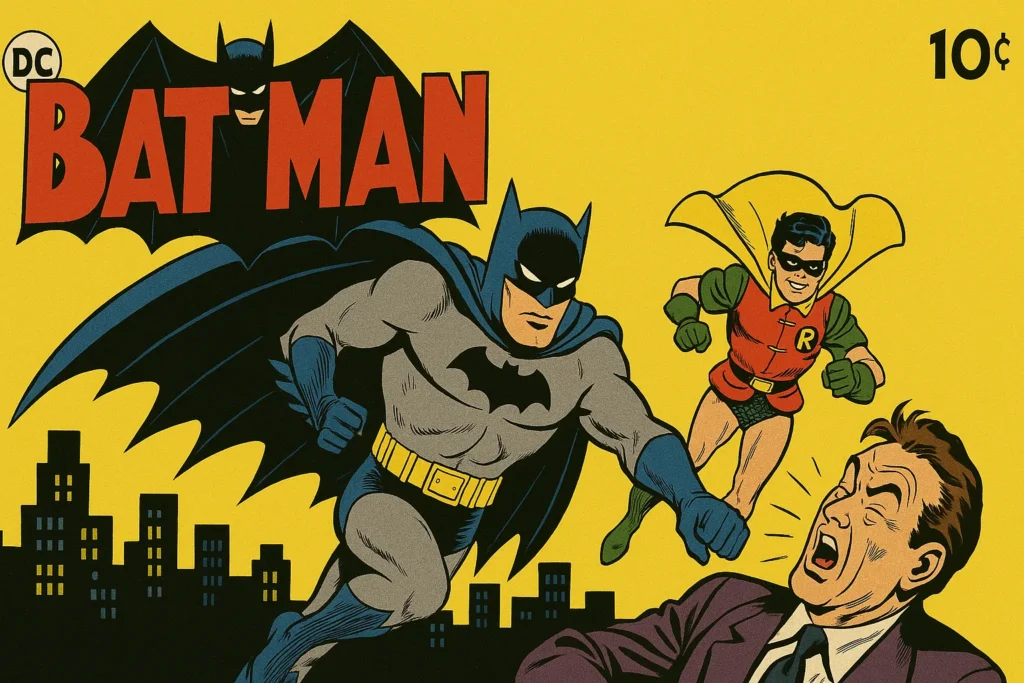
To understand Batman’s present, you need to visit his past. The Golden Age (1939–1956) and Silver Age (1956–early 1970s) were the foundational decades that established Batman’s core identity, supporting cast, and iconic rogues gallery. This era defined not just the Dark Knight himself, but the superhero genre as a whole.
The Birth of the Bat (1939)
Batman made his legendary debut in Detective Comics #27 (1939), created by Bob Kane and Bill Finger. Unlike Superman’s brighter, idealistic presence, Batman was a darker, more mysterious figure—a masked detective operating in the shadows of Gotham City.
Early stories leaned heavily on noir, crime thrillers, and pulp fiction influences. Batman even carried a gun in his earliest appearances, a trait quickly dropped as the character evolved into a more moral figure.
The First Wave of Villains & Allies
In the 1940s, the mythology grew fast:
- The Joker, Catwoman, and Penguin were all introduced within Batman’s first few issues.
- Robin the Boy Wonder debuted in Detective Comics #38 (1940), shifting Batman from lone avenger to mentor figure.
- Alfred Pennyworth, Commissioner Gordon, and the iconic Batcave followed soon after.
These years introduced core ideas that would endure for generations.
Silver Age Shifts: Sci-Fi & Super-Friends
The Silver Age (mid-1950s through early 1970s) reflected the pop culture of the time—more colorful, campy, and surreal. Under the influence of the Comics Code Authority, Batman stories became more sanitized, often featuring:
- Outlandish sci-fi villains (alien invaders, monster transformations)
- Whimsical gadgets and rainbow Batsuits
- Frequent team-ups with Superman in World’s Finest Comics
While this era is often remembered for its goofy tone (and the 1960s Adam West TV show), it also reinforced Batman’s mainstream popularity and laid the groundwork for his eventual return to darkness.
Key Issues and Storylines from This Era
| Title | Issue |
| Detective Comics #27 (1939) | First appearance of Batman |
| Batman #1 (1940) | Debut of the Joker and Catwoman |
| Detective Comics #205 (1954) | “The Origin of the Batcave” |
| Batman #131 (1960) | “The Death of Robin” — a dramatic, early what-if scenario |
| The Joker’s Five-Way Revenge! | Batman #251 (1973) |
Who Should Read This Era?
- Completists who want to see where it all began
- Historically curious readers who love the evolution of the comic medium
- Fans of retro aesthetics, detective fiction, and Silver Age charm
For most modern readers, this era isn’t required reading—but it’s deeply rewarding for those interested in the full arc of Batman’s growth as a character.
2.Bronze Age & The Gritty Turn (1970s–1980s)
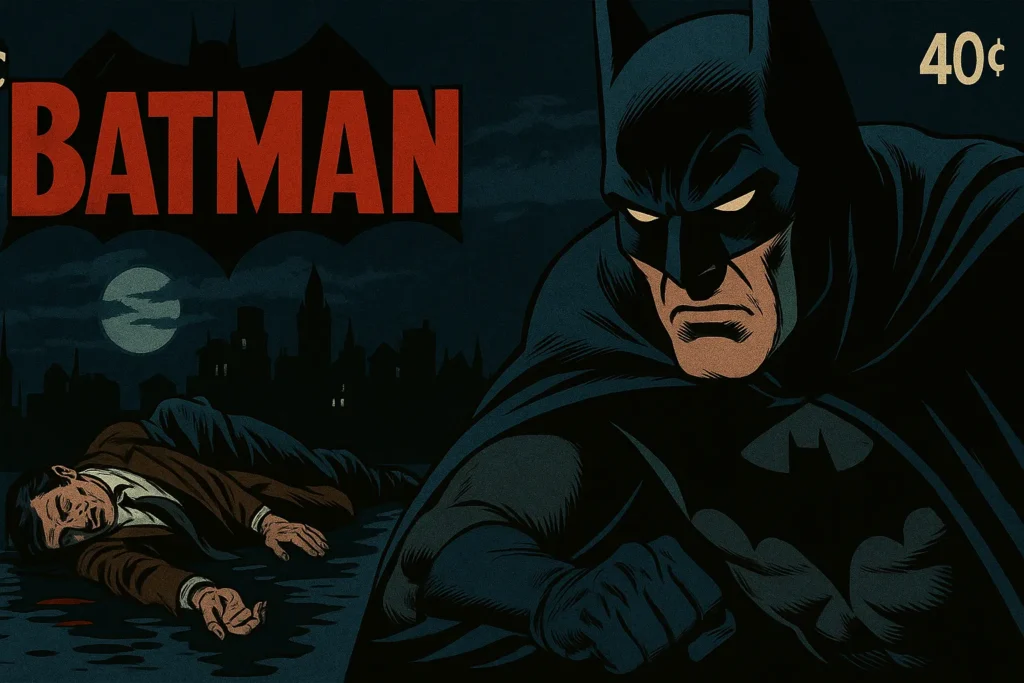
The Bronze Age of Comics (early 1970s through mid-1980s) marked a dramatic shift in Batman’s tone and storytelling. After years of colorful camp and sci-fi absurdity, the Dark Knight returned to his noir roots—becoming once again a haunted, obsessive detective patrolling Gotham’s shadows.
This was the era that reclaimed Batman’s identity as a serious, morally complex hero.
Enter Neal Adams & Dennis O’Neil
Few creative teams have impacted Batman as deeply as writer Dennis O’Neil and artist Neal Adams. Starting in the late 1960s and continuing into the ’70s, they revolutionized the character by:
- Dismissing the campiness of the Silver Age
- Reinventing Batman as a brooding, grounded crime-fighter
- Reintroducing classic villains like Two-Face with psychological depth
- Introducing new threats like Ra’s al Ghul and Talia al Ghul, who added international scope and philosophical complexity
This was the first serious attempt to blend pulp noir, martial arts, and gothic horror—a formula that would define Batman for decades to come.
The Joker Becomes Dangerous Again
Batman’s greatest enemy also evolved during this time. Gone was the prankster clown of the 1950s and 1960s.
- In Batman #251 (1973), “The Joker’s Five-Way Revenge!”, the Clown Prince of Crime returns as a violent, unpredictable murderer.
- Written by O’Neil and drawn by Adams, this story is widely credited with re-establishing the Joker as a terrifying threat—a move that would inspire The Killing Joke, The Dark Knight Returns, and later films.
Essential Reads from the Bronze Age
| Title | Why It Matters |
| Batman: Strange Apparitions (Detective Comics #469–476) | A detective-focused arc featuring Hugo Strange, Silver St. Cloud, and the original Clayface |
| The Joker’s Five-Way Revenge! (Batman #251) | Landmark Joker story that revived his menace |
| Batman: The Demon Lives Again (Batman #244) | Iconic sword duel with Ra’s al Ghul; peak Adams artwork |
| Detective Comics #457 (“There is No Hope in Crime Alley”) | Heartfelt tale about Bruce Wayne returning to the place where his parents died |
| Brave and the Bold team-up stories | Showcased Batman’s growing role as a leader within the DC Universe, including with Green Arrow, Black Canary, and others |
Why This Era Matters
- Set the stage for the Post-Crisis “modern Batman”
- Introduced core mythology like the League of Assassins and Batman’s global reach
- Re-established Batman as a psychologically grounded vigilante, not a superhero with gadgets
- Showed that comic books could tackle mature, socially relevant themes (urban decay, justice, moral compromise)
Who Should Read the Bronze Age?
- Readers who love detective noir, espionage, and grounded crime stories
- Fans of Ra’s al Ghul, Talia, and a sharper, more violent Joker
- Anyone who wants to understand the DNA of Batman Begins, The Batman (2022), and even the Arkham video games
3.The Modern Era / Post-Crisis (1986–2011)
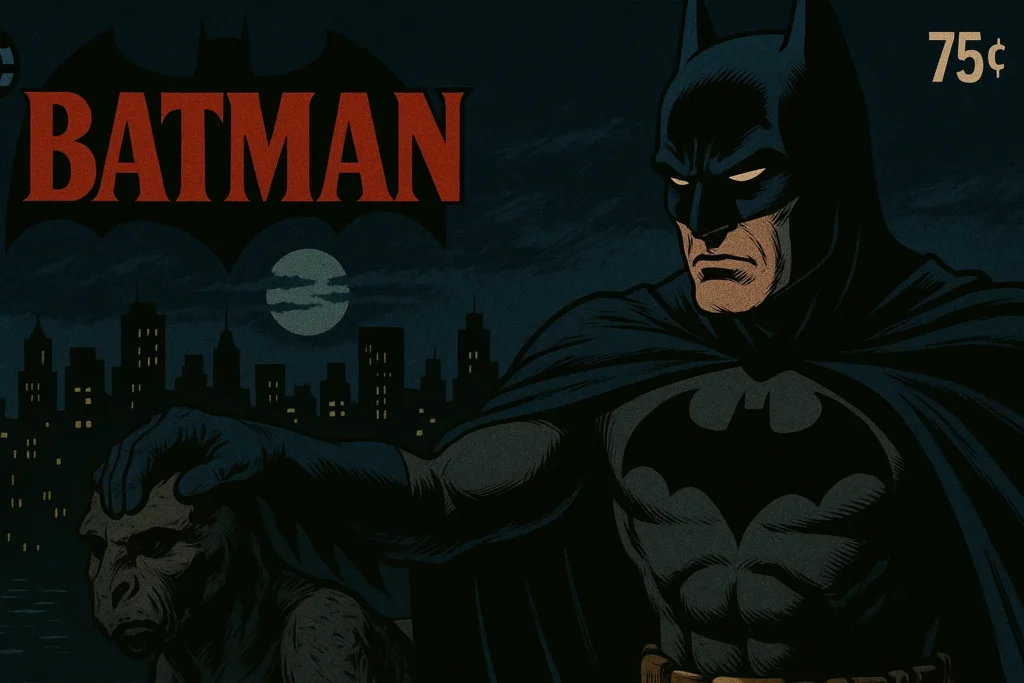
For many fans, this is the era where Batman truly comes into focus—as a psychologically rich, deeply flawed character at the center of a darker and more mature Gotham. Following the monumental Crisis on Infinite Earths event in 1985–86, DC Comics rebooted much of its continuity, giving Batman a refined origin, deeper emotional stakes, and a sprawling narrative that would define his legacy for decades.
This is the most recommended starting point for modern readers.
Defining Batman’s Origins (Again)
The post-Crisis years were all about grounding the myth. Right out of the gate, Frank Miller and David Mazzucchelli redefined Batman’s beginnings with:
- Batman: Year One
A gritty, street-level origin story that explores Bruce Wayne’s first year as the Dark Knight, alongside Jim Gordon’s rise in the corrupt Gotham PD.
This became the blueprint for modern Batman storytelling, inspiring Batman Begins and countless adaptations.
Tragedy, Trauma, and Evolution
The Modern Era is where Batman’s world gets truly layered. Key story arcs explored:
- Batman’s early enemies (The Man Who Laughs)
- Gotham’s mafia history and Harvey Dent’s fall (The Long Halloween, Dark Victory)
- The Joker’s cruelty (The Killing Joke)
- The loss and rebirth of Robins (A Death in the Family, A Lonely Place of Dying)
- Batman’s physical and mental breaking point (Knightfall)
- City-wide disasters (Contagion, No Man’s Land)
- Emotional betrayals (Hush, Under the Red Hood)
Each arc built upon the last, giving Batman a rich emotional timeline filled with allies, enemies, and inner demons.
Legacy and the Bat-Family
This era also fleshed out the Bat-Family:
- Dick Grayson becomes Nightwing and later Batman himself
- Jason Todd dies and returns
- Tim Drake proves himself as the brainy, tactical Robin
- Barbara Gordon transforms into Oracle after The Killing Joke
- Cassandra Cain, Stephanie Brown, and Damian Wayne all enter the picture
As Batman ages, we see him as mentor, father figure, and reluctant leader of an expanding vigilante dynasty.
Suggested Reading Order
Here’s a streamlined guide to navigating this era:
| Title | Notes |
| Batman: Year One | Essential origin story |
| Batman: The Man Who Laughs | First Joker encounter (post-Year One) |
| The Long Halloween / Dark Victory | Crime sagas with Harvey Dent, Catwoman, Falcone family |
| Robin: Year One, Batgirl: Year One, Nightwing: Year One | Sidekick spotlight stories |
| The Killing Joke | Tragic Joker tale with lasting consequences |
| A Death in the Family | Jason Todd’s infamous end |
| A Lonely Place of Dying | Tim Drake becomes Robin |
| Knightfall Saga | Bane breaks Batman; Azrael temporarily takes the mantle |
| Contagion, Legacy, Cataclysm, No Man’s Land | Gotham faces plagues, earthquakes, and isolation |
| Hush | High-stakes modern arc with mystery and betrayal |
| Under the Red Hood | Jason Todd returns with vengeance |
| Batman by Grant Morrison | Epic run: Batman & Son, R.I.P., Batman & Robin, Batman Incorporated |
| The Black Mirror | Dick Grayson as Batman in a noir detective thriller |
Why This Era Is Essential
- Narrative cohesion: Stories build on each other in a coherent timeline
- Character development: The Bat-Family is expanded and given emotional weight
- Cultural impact: Many arcs from this era have been adapted into film, animation, and games
- Psychological depth: Batman evolves into a tragic, obsessive figure defined by trauma and responsibility
Who Should Start Here?
- New readers looking for a modern entry point
- Fans of The Dark Knight Trilogy, Arkham games, or Batman: The Animated Series
- Collectors interested in complete story arcs with long-term payoffs
4.The New 52 Era (2011–2016)
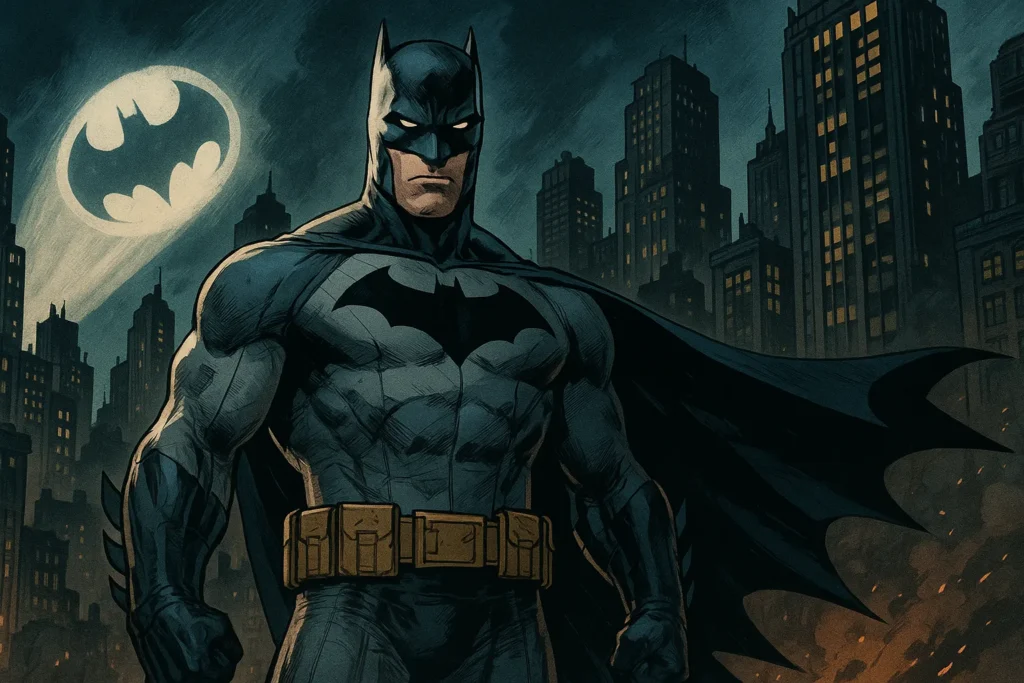
In 2011, DC Comics hit the reset button with The New 52, a sweeping reboot of its entire universe. Every title restarted at issue #1, and Batman was no exception. But unlike other heroes, Batman’s continuity wasn’t fully erased—his major past arcs (like Year One, Hush, and The Killing Joke) were mostly retained, while his timeline was condensed to fit a more streamlined universe.
The result? A bold, visually dynamic reinvention of the Batman mythos for a new generation—faster-paced, modernized, and more accessible.
Snyder & Capullo: A New Defining Duo
The creative team of Scott Snyder (writer) and Greg Capullo (artist) led the main Batman title during this era—and delivered some of the most critically acclaimed stories of the 2010s. Their work redefined Gotham’s history and reimagined classic villains in terrifying new ways.
Key Arcs in The New 52 Batman (Vol. 2)
| Arc | Issues | Description |
| The Court of Owls | #1–11 | A secret society that has ruled Gotham in the shadows for centuries. Introduced the Talons. Instant classic. |
| Death of the Family | #13–17 | The Joker returns with a grotesque plan to sever Batman from his allies. Deeply psychological and disturbing. |
| Zero Year | #21–33 | A reimagined origin story, replacing Year One in New 52 canon. More bombastic and high-tech. |
| Endgame | #35–40 | The Joker’s final gambit—violent, apocalyptic, and operatic. Ends with a shocking twist. |
Other Notable New 52 Batman Titles
- Batman Eternal (weekly, 52 issues): A massive Gotham-wide saga spotlighting the Bat-Family and supporting cast.
- Detective Comics: Focused on traditional detective storytelling, though not as consistently strong as Batman.
- Batman and Robin by Peter J. Tomasi: Focuses on Bruce and Damian Wayne’s tense but loving father-son relationship.
- Batgirl, Nightwing, Red Hood and the Outlaws, Batwoman: These titles explored Bat-Family members with fresh starts and retooled backstories.
Strengths of the New 52 Era
- Perfect entry point: You don’t need to read anything before Batman (2011) #1.
- Unified creative vision: Snyder & Capullo’s run is narratively and thematically cohesive.
- Modern energy: High production values, cinematic art, and fast-paced storytelling.
- Expanded Bat-Family focus: Side characters got their own series and emotional depth.
Weak Spots to Note
- Continuity compression: Trying to fit decades of Batman history into a 5-year timeline confused some fans.
- Mixed quality: Some tie-ins and side titles lacked consistency or depth.
- Debates about tone: While exciting, some readers found the stories too over-the-top compared to earlier grounded arcs.
Who Should Start Here?
- New readers who want a clean, modern launch point
- Fans of big, high-stakes comic storytelling with a cinematic flair
- Readers interested in deepening their knowledge of Gotham’s hidden history (Court of Owls is essential)
5. DC Rebirth & Current Era (2016–Present)
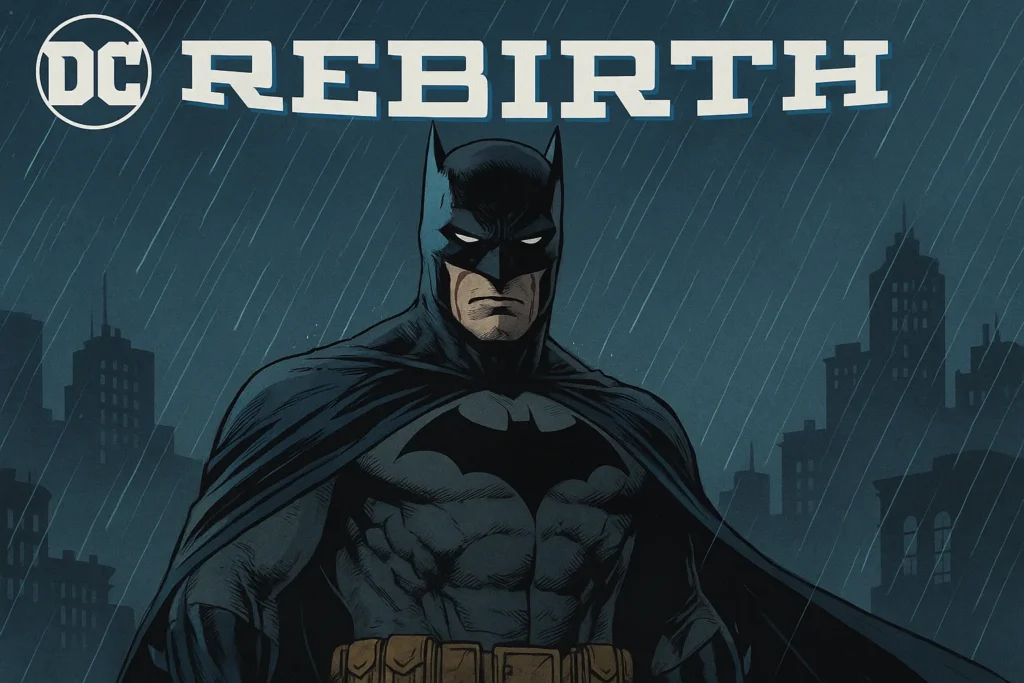
Following the New 52’s ambitious but controversial reboot, DC launched Rebirth in 2016—a publishing initiative that aimed to restore the emotional legacy, history, and relationships that many fans felt were missing. For Batman, this meant honoring the past while still pushing the character into new psychological and narrative territory.
From Tom King’s introspective storytelling to the current era of big events and cosmic consequences, this period represents a dynamic fusion of old and new.
Tom King’s Batman (Rebirth Era: Batman Vol. 3, Issues #1–85)
Tom King’s run focused heavily on Batman’s emotional core, his relationship with Catwoman, and the existential burden of being Gotham’s protector. Rather than traditional crime-fighting, this run is steeped in psychological conflict, trauma, and love.
Key Arcs:
| Arc | Issues | Highlights |
| I Am Gotham | #1–6 | Batman meets two new heroes—Gotham and Gotham Girl—with tragic results. |
| I Am Suicide | #9–13 | Batman forms a Suicide Squad-like team to infiltrate Bane’s fortress. |
| I Am Bane | #16–20 | A brutal rematch with Bane, with high emotional stakes. |
| The War of Jokes and Riddles | #25–32 | A flashback story set early in Batman’s career—Joker vs. Riddler in a deadly turf war. |
| Batman #50 | The infamous wedding issue—Batman and Catwoman’s romance hits a turning point. | |
| City of Bane | #75–85 | Bane takes control of Gotham. A psychological and literal battle for Batman’s soul. |
King’s run is polarizing—loved for its ambition, criticized for its pacing—but undeniably bold and emotionally resonant.
James Tynion IV’s Run (2020–2021)
Tynion shifted the focus back to action, mystery, and new characters. He introduced:
- Punchline (Joker’s new partner)
- Clownhunter and Ghost-Maker (vigilantes with unique moral codes)
- Events like Joker War and Fear State that rocked Gotham’s foundation
His run was fast-paced and high-concept, blending tech, horror, and political paranoia into a modern Gotham thriller.
Chip Zdarsky’s Run (2022–Present)
Currently writing Batman, Chip Zdarsky is digging deep into Bruce Wayne’s identity, using multiverse theory, time travel, and moral conflict to question what makes Batman who he is.
Major arcs include:
- Failsafe: A Batman failsafe AI turns against him, forcing Bruce to question his own limits.
- The Bat-Man of Gotham: A multiverse twist that drops Batman into a dystopian world where he never existed.
Zdarsky’s take blends high-concept storytelling with emotional grounding—perfect for modern readers who want Batman at his most philosophical and physically challenged.
Notable Events & Crossover Arcs
| Event | Notes |
| Joker War | The Joker seizes Wayne Enterprises and Gotham itself—Bat-Family scramble to respond. |
| Fear State | Gotham descends into authoritarian chaos under Scarecrow and Simon Saint. |
| Shadow War, Dark Crisis, Knight Terrors | Larger DC Universe crossovers with Batman as a central figure. |
Who Should Start with Rebirth or Current Batman?
- Readers who want character-driven drama, especially regarding Batman/Catwoman
- Fans interested in new characters and evolving roles in the Bat-Family
- Those who’ve read New 52 or earlier runs and want to continue forward
Strengths of the Rebirth Era
- Reconnects Batman with his emotional roots and classic relationships
- Introduces new characters and ethical dilemmas
- Continues the tradition of bold, risk-taking storytelling
- Easy to follow with collected editions and digital bundles
6. Essential Graphic Novels (Can Be Read Anytime)
While many Batman stories unfold in long, interconnected arcs, some of the most powerful and celebrated tales are self-contained graphic novels. These books don’t require extensive background knowledge and can be read anytime, making them perfect for:
- New readers seeking iconic stories
- Busy fans wanting short, complete reads
- Collectors curating cornerstone titles for their library
These stories often exist slightly outside of continuity—or embrace it in minimal ways—yet their impact on Batman lore is monumental.
Must-Read Graphic Novels
Batman: The Dark Knight Returns
- By: Frank Miller & Klaus Janson
- Why it matters: A legendary, dystopian story of an aging Bruce Wayne donning the cowl one last time. Gritty, political, mythic.
- Standalone: Yes, and universally respected.
Batman: Arkham Asylum
- By: Grant Morrison & Dave McKean
- Why it matters: A psychological deep dive into Bruce’s mind and the madness of his enemies. Dreamlike, dark, symbolic.
- Tone: Horror meets art house.
Batman: The Black Mirror
- By: Scott Snyder & Jock/Francavilla
- Why it matters: A noir crime thriller featuring Dick Grayson as Batman. Dark, brutal, and emotionally intense.
- Entry Point: Great for fans who liked The Batman (2022 film).
Batman: Ego and Other Tails
- By: Darwyn Cooke
- Why it matters: A philosophical story of Bruce wrestling with his dual identity. Short, powerful, and visually gorgeous.
- Vibe: Thoughtful and haunting.
Batman: Venom
- By: Denny O’Neil & Trevor Von Eeden
- Why it matters: Explores Batman’s vulnerability and the origins of the Venom drug (later linked to Bane).
- Perfect for: Those who enjoy moral dilemmas and physical stakes.
Gotham Central
- By: Greg Rucka & Ed Brubaker
- Why it matters: Follows the GCPD trying to police Gotham under Batman’s shadow. Smart, grounded, and tense.
- Structure: Procedural-style storytelling with deep character work.
Why These Graphic Novels Matter
- Great Jumping-On Points: No long reading commitment or backstory required
- Critically Acclaimed: Each is frequently listed among the best Batman comics ever
- Tone Variety: From psychological thrillers to grounded detective stories, there’s something for every mood
- Standalone Collectibles: These are ideal gifts and must-haves for any comic bookshelf
Pro Tip:
Many of these graphic novels are available in deluxe editions or collected omnibuses. They’re often kept in print year-round, making them easy to find in bookstores or online.
7. Reference Table: Major Batman Story Arcs & Key Collections
This quick-reference table distills Batman’s most essential story arcs, along with their recommended reading format and why they matter. Whether you’re building a collection, diving into Batman’s best moments, or mapping out your next read — this table is a shortcut to the core of Batman’s mythos.
| Story Arc | Where to Read | Why It’s Important |
| Year One | Batman #404–407 (TPB available) | Definitive origin story for Batman post-Crisis. Gritty and grounded. |
| The Long Halloween | 13-issue series (TPB/Deluxe HC) | A noir murder mystery; essential for Harvey Dent’s transformation. |
| Dark Victory | 13-issue series (TPB) | Sequel to Long Halloween. Introduces Dick Grayson as Robin. |
| The Killing Joke | One-shot graphic novel | Iconic Joker story. Influenced The Dark Knight film. |
| Knightfall | Collected in 3–4 volumes | Bane breaks Batman. Explores themes of legacy and worthiness. |
| No Man’s Land | 5+ TPB volumes or omnibus | Gotham is isolated; Batman and allies fight for survival and hope. |
| Hush | Batman #608–619 (TPB/Deluxe HC) | High-octane mystery with appearances from nearly every major villain. |
| Court of Owls | Batman Vol. 2 #1–11 | Introduces a secret society manipulating Gotham. New 52 essential. |
| Endgame | Batman Vol. 2 #35–40 | The Joker at his most dangerous. Snyder/Capullo’s climax. |
| Rebirth Era (Tom King) | Batman Vol. 3 #1–85 | Psychological, romantic, and emotionally deep take on Batman. |
How to Use This Table
- New Readers: Start with Year One, then explore Long Halloween, Hush, and Court of Owls.
- Collectors: Focus on TPB or deluxe editions—many are part of boxed sets or omnibuses.
- Chronology Seekers: Use this to build a personalized timeline of Batman’s growth across different publishing eras.
- Bloggers/Reviewers: Use the “Why It’s Important” column to form article hooks or review intros.
8. Tips for New Readers
Batman’s publishing history can be intimidating — with thousands of issues, multiple timelines, and shifting continuities. Whether you’re a newcomer or returning fan, these tips will help you read smarter and enjoy deeper.
1. Start with Modern Origins
If you’re brand new to Batman, begin with modern retellings that serve as clean starting points:
- Batman: Year One — Gritty, foundational.
- The Long Halloween — Builds on Year One with a detective noir tone.
- The Killing Joke — A Joker essential, often read early in fan journeys.
These three form the “starter trilogy” for most readers.
2. Use Major Arcs to Navigate
Instead of trying to read every issue in order, use landmark story arcs as guideposts:
- Knightfall → No Man’s Land → Hush → Court of Owls → Endgame
These arcs reflect the evolution of Batman, Gotham, and the Bat-Family.
3. Look for Jumping-On Points
DC Comics has built-in “reset” moments ideal for new readers:
- Post-Crisis Modern Era (1986–) – Begins with Year One
- The New 52 (2011) – Clean reboot with Court of Owls
- DC Rebirth (2016) – Return to legacy and emotional storytelling
Pick one based on your preference for tone: gritty, epic, or emotional.
4. Don’t Skip Standalone Graphic Novels
You don’t need deep continuity knowledge to enjoy:
- The Dark Knight Returns
- Arkham Asylum
- Batman: Ego
- Batman: Black Mirror
These are often self-contained and artistically daring — great for casual reading.
5. Read What Interests You Most
Are you here for the Joker? Try The Killing Joke or Endgame.
Love Bat-Family dynamics? Try Batman & Robin or Batman Eternal.
Prefer detective stories? The Long Halloween and The Black Mirror are excellent picks.
You don’t need to read everything. Start where your curiosity leads — and build from there.
6. Use Guides (Like This One!)
Resources like this blog and trusted sites (Comic Book Herald, Comic Book Treasury, Reddit guides) are invaluable for planning your reading and avoiding confusion.
Bookmark a few reading order pages and use them as your Batman compass.
Final Words
Batman isn’t just a comic book character — he’s a mythos. His stories span over 80 years of publication, dozens of legendary creators, and countless reimagining. Whether you’re here to explore the psychological depths of Bruce Wayne, follow the rise and fall of Robins, or witness epic showdowns with the Joker, there’s a Batman era or storyline waiting for you.
This guide aims to simplify the overwhelming and give you a clear, era-by-era path to enjoy the Dark Knight’s greatest moments. Whether you read chronologically, by event, or jump into iconic arcs, Batman’s world rewards patience, curiosity, and passion.
No matter where you start — just start. The cape awaits.
StartWithComics Team
FAQ
What’s the best starting point for new Batman readers?
Start with Batman: Year One by Frank Miller. It’s a modern, accessible origin story and leads well into The Long Halloween and The Killing Joke.
Do I need to read every Batman comic to understand the story?
No. Focus on major arcs like Knightfall, Hush, Court of Owls, and The Black Mirror. You can enjoy Batman without reading every issue — this guide highlights key points.
What’s the difference between The New 52 and Rebirth?
The New 52 (2011) rebooted DC’s continuity, including Batman, while Rebirth (2016) restored legacy elements and aimed to balance fresh starts with emotional depth. Both are good entry points.
Can I read standalone graphic novels without knowing continuity?
Absolutely. Stories like The Dark Knight Returns, Arkham Asylum, and Batman: Ego are self-contained and great for casual or experimental reading.
Where can I find these comics?
You can read them through:
1. Digital platforms like DC Universe Infinite, Comixology, Kindle
2. Collected TPBs and graphic novels from bookstores or comic shops
3. Omnibus editions for collectors.






